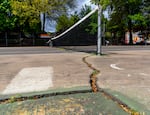
The tennis court at Colonel Summers Park in Southeast Portland, April 21, 2025. A new audit details facilities across Portland that are in need of repair.
Kristyna Wentz-Graff / OPB
Broken crosswalk lights. Tennis courts split open with uneven asphalt. Playground slides covered in rust. A fire station roof leaking water. Broken sewage pipes. A public restroom with a rodent infestation.
Years of neglect has left Portland roads, buildings, parks facilities, water systems, technology and other types of infrastructure deteriorating at an unsafe — and expensive — pace. The city owns nearly $75 billion in these types of structures and equipment, and much of it was built over 50 years ago. According to a city audit released Wednesday, most of the city’s infrastructure is “near or beyond the end of its useful life.” And it would cost the city more than $1 billion per year to make needed repairs.
“For years, the city has underinvested in routine and preventative maintenance of its aging assets,” reads the audit, led by City Auditor Simone Rede. “This underinvestment has created a backlog of costly and increasingly urgent needs that the city does not have the funding to meet.”

The Creston Park pool in Southeast Portland, April 21, 2025. According to the city’s website, new fencing will replace the existing chain link fencing, for increased security and safety.
Kristyna Wentz-Graff / OPB
The audit, which is only the latest in a yearslong string of city reports raising alarm about its crumbling infrastructure, says continued neglect could lead to lawsuits against the city, environmental harm, and even larger repair costs in the future.
The cost has already ticked upward. According to city data, repairing aging infrastructure was estimated to cost the city about $300 million a decade ago. Left unaddressed, that bill rose to $500 million by 2019. And the latest estimate from 2023 puts the cost at $1.4 billion.
Portland’s new city leaders, already preparing to make deep funding cuts to balance this year’s budget, have few options to address the immense maintenance backlog. But the audit’s authors are hopeful that the city’s new elected officials, working under a new governance model, can dig the city out of this crisis.
Under the city’s previous form of government, members of city council oversaw city bureaus and their budgets. There was no central plan to address aging infrastructure, leaving it up to each politician to decide whether to prioritize paying for maintenance over new or popular programs.
“I think they were oftentimes just focused on a shiny object that made political sense for them,” said District 4 City Councilor Olivia Clark, whose campaign platform included addressing the city’s maintenance backlog. “And they weren’t held accountable.”
The new government system centralizes all city bureaus under the new City Administrator’s office, in an attempt to remove politics from budget decisions. The audit recommends putting the administrator’s office in charge of creating a streamlined system to repair the city’s infrastructure and create a long term maintenance plan.
This would allow for a citywide analysis of which types of projects should be prioritized for repair, instead of pitting bureau budgets against each other. That kind of analysis currently doesn’t exist.

A person walks past a soccer area at Colonel Summers Park in Southeast Portland, April 21, 2025. The city website says the park received “several major improvements” in 2017. A new audit details facilities across Portland that are in need of repair.
Kristyna Wentz-Graff / OPB
“For example,” the report notes, “there is no guidance for what to consider when evaluating funding for a radio tower versus a green space versus a ladder truck.”
City Administrator Michael Jordan supports the auditor’s recommendations.
In a letter to Rede, Jordan wrote that the change in city government “presents a unique opportunity to shift from disconnected and frequently ad hoc management of the City’s assets to a more coordinated and strategic approach.”
He pledged to get a new system up and running by late 2027.
But some city councilors want something sooner. Clark, who chairs the city’s Transportation and Infrastructure Committee, plans to introduce an ordinance next month that would direct Jordan to create a citywide asset management system, similar to what the audit proposes.
“It’s like we have an adult in the room now,” said Clark, referring to the new city administrator position. “This will set standards across all the bureaus about how they’ll deal with asset management so we have a common set of expectations.”
Clark’s plan is similar to another ordinance led by District 1 Councilor Loretta Smith and District 4 Councilor Mitch Green. That proposal, which is headed to council this week, asks the transportation bureau to craft a strategy to repair and maintain aging streets and sidewalks.
What’s still missing in the conversation is how to pay for all of this. A previous city facilities report, referenced in this week’s audit, estimated it costing the city around $10 billion to keep these assets maintained over the next decade.

Crumbling stairs at Creston Park in Southeast Portland, April 21, 2025.
Kristyna Wentz-Graff / OPB
Clark suggested placing a general obligation bond, which would raise property taxes, on a ballot in the coming years to fund maintenance. Clark said she’s certain there’s no appetite for a new local tax (an instinct supported by recent polling), but hopes that attitudes will change in the near future, once Portlanders start seeing improvements to homelessness and public safety concerns.
“We have to show that we’re gonna turn the city around first,” she said.
In the meantime, she wants to see the city’s administrative branch address what she considers to be an “intergenerational threat” to Portland
“If we keep going in this direction, we’re gonna leave it to our children to deal with these failures,” she said. “It’s gonna take some time, but I’m very optimistic about what this new form of government will do.
